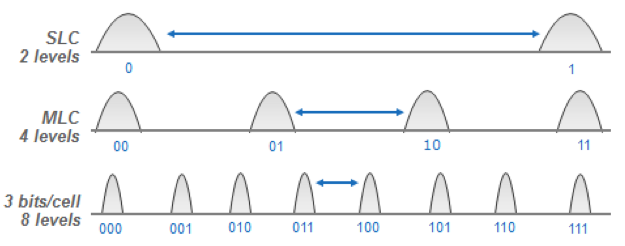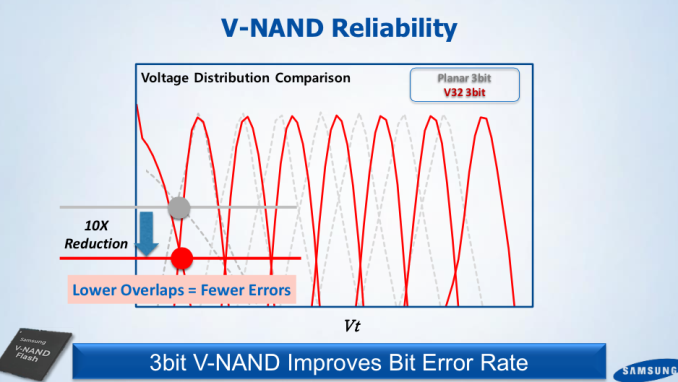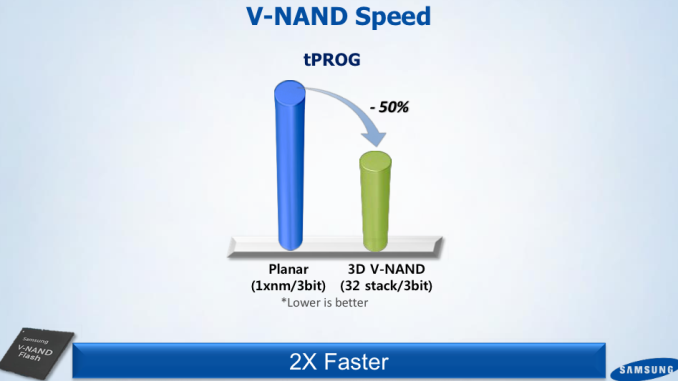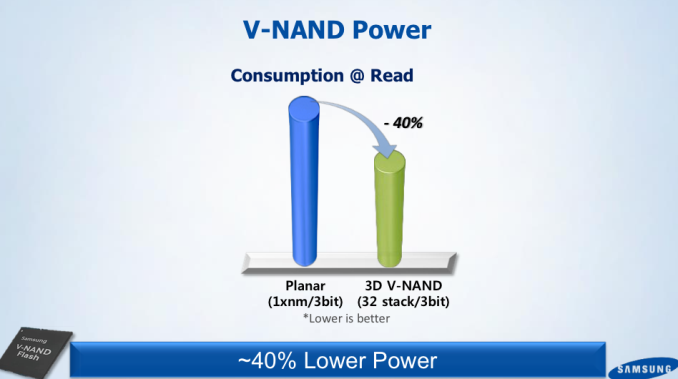Samsung SSD 850 EVO (120GB, 250GB, 500GB & 1TB) Review
by Kristian Vättö on December 8, 2014 10:00 AM ESTThree Bits and Three Dimensions: What's the Deal?
I've covered 3D NAND and TLC NAND in detail in the past and in this article I'll just explain what 3D technology means to TLC NAND and vice versa, so head over to the links above if you are in the search for a deeper analysis of the two technologies.
Truth to be told, 3D technology is ideal for TLC. The fundamental problem of TLC NAND has always been the limited endurance and performance, which is caused by the additional voltage states that are needed to store three bits (i.e. eight possible bit outputs) in one cell. With eight voltage states compared to four in MLC, TLC NAND is less resistant to wear out because it takes a smaller change in the cell charge to corrupt the cell value. Due to the way NAND works, the cells (or the insulators in the cell to be exact) wear out over time, which induces electron leakage that alters the cell charge and hence the voltage state. This gets worse with die shrinks because the number of electrons decreases, making the NAND even less tolerant to wear out.
The key aspect of 3D V-NAND is the process node. By going back to 40nm lithography, the number of electrons increase exponentially, which makes TLC a much more viable technology than it was with modern planar NAND. Obviously, V-NAND doesn't change the basics of TLC NAND because it still takes eight voltage states to differentiate all the possible 3-bit outputs, but thanks to the increased number of electrons there is more breathing room between the states and thus the cells are more error tolerant.
Samsung claims 10x reduction in voltage state overlaps, which is a massive change for the better. You can see how crammed the planar TLC voltage states are, so it's no wonder that the endurance is low because the states are practically overlapping at each point in the voltage distribution and hence even tiny changes in the cell voltage can alter the cell's voltage state.
The larger cell structure also enables higher performance because it takes less iterations to program a cell. With planar TLC NAND it took multiple very high voltage pulses as well as numerous verification process to reach the right charge, but with looser voltage distribution the programming process has less steps and thus takes less time.
And given the lower read/program latencies and less need for error correction, the power consumption is also considerably lower.
In addition to better latency and power consumption characteristics, Samsung claims doubled the density over its 19nm planar TLC NAND, but without knowing the die size of 128Gbit 32-layer TLC V-NAND, it's hard to say how accurate this is. There have been some whispering that the 128Gbit die would actually be identical to the 86Gbit MLC die because 86Gbit multiplied by 1.5 equals 129Gbit and at the silicon level MLC and TLC aren't any different, but for now that's just speculation.
What I do know is that Samsung started the mass production of TLC V-NAND later, which suggests that the two aren't completely uniform. Moreover, from what I know TLC NAND requires some changes to the peripheral circuitry in order to read three bits from one cell, so while the NAND memory arrays could be alike the die size is still likely at least slightly different. Anyway, we'll find out when Chipworks (or some other silicon analysis company) takes a closer look at the NAND die itself.















97 Comments
View All Comments
Kevin G - Monday, December 8, 2014 - link
What version is the firmware of the 840 EVO? There is a notorious bug out there that'll drastically reduce the speed of the drive when it attempts to read data.See:
http://www.anandtech.com/show/8617/samsung-release...
romrunning - Monday, December 8, 2014 - link
That's the bug about reading really old data. If he did an upgrade, then it wouldn't be really old data on the new drive.It also doesn't apply to the point he was making - would I subjectively "feel" the difference if I upgrade to the 850 EVO from an older <insert_brand_here> SSD?
doggghouse - Monday, December 8, 2014 - link
On one of these review sites, they mentioned that the step up from HDD to SSD is enormous, but between the different generations of SSD the difference isn't nearly as noticeable. Depending on the test, the difference between HDD and SSD is anywhere from 2.5x faster (ex. sequential write) to 140x faster (ex. random write). You definitely will not see such a marked improvement going from one SSD to another.Also I agree with your point about the benchmarks being pointless for the average user. A lot of the benchmarks are geared towards enterprise usage. I think part of the problem is that the drives all behave pretty similarly (compared to HDD anyway), until they are pushed to the extremes. That's the only way for the reviews to differentiate between them, unless they find a particular weak point or flaw.
eanazag - Monday, December 8, 2014 - link
The performance profile of the drives and your workload will dictate if you notice the better performance. I would guess that you got a lot more GBs/$ when you picked up the Evo versus the Corsair drive. Also, not you don't need to struggle to get everything on to your boot drive. At the same time your computer may only startup 2 or 3 seconds faster.They don't for an average user, but if you're here there's a good chance you're not an average user. And those fancy benchmark numbers cost you what?
There are real life workloads that will benefit for an average user. I have seen the consistency play out in my usage in various drives. I have seen garbage collection routines cause some painful performance issues in software encrypted drives.
MrSpadge - Monday, December 8, 2014 - link
With a half-decent SSD your I/O is probalby mostly CPU-limited in the real world anyway.ummduh - Monday, December 8, 2014 - link
In my opinion, the best reason to continue to upgrade, is capacity increases.My first drive was 60GB, my second is 120GB, looks like my third is going to be 250GB....
No the speed difference isn't that drastic once you get off the HDD, but now you can start keeping more and more stuff on a drive at the same price point. All of my drives have been at the $150 point.. (Ok, so I had 3 different 60GB drives, but that was due to not realizing how bad OCZ suuuuuucked and I kept going back like a moron)
cm2187 - Tuesday, December 9, 2014 - link
The other thing is that most SSDs now are limited by the SATA interface. And to be honest, unless you are running a database with thousands of queries per seconds, beating the SATA interface won't really add much to your experience. Larger capacities I think would be more useful.Badelhas - Thursday, December 11, 2014 - link
Thats exactly what I always think when I read this reviews. Altough they are great to read, for someone who already has a SSD the gains are not noticeable. I have a Vertex 3 120Gb that I bought in 2011 and been questioning myself if I would se any real gains going to a 840 Evo, for instance, since they are much newer but you just answered my question ;)matej_eu - Thursday, June 25, 2015 - link
I am in a similar situation. My first SSD was the ADATA's SP600@64GB running on SataII, I was so mesmerized by the speed of everything (boot time, installation, app run in time, ...). I really do take care of my Win installation, drivers, and apps, but in the end size was to small for boot+main drive in laptop. I bought Samsung 840 EVO@120GB, and in the recent times I thought I was going crazy, system was noticeably slowing down. I googled, and what do you now, problems, no more Samsung EVOs for me!! Buy Samsung 8x0 PRO or some other brand.milli - Monday, December 8, 2014 - link
Your Intel SSD 730 prices are wrong. They might have gone up.The price of the ARC 100 is amazing ATM. It scores very good in the '2013 Storage Bench service time' which in my experience tells the most about how SSDs feel in actual usage.